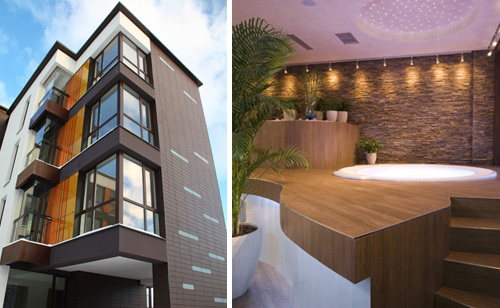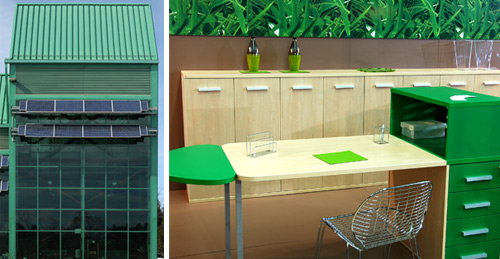Color in the Built Environment: Past, Present, and Future
Conservative warm neutrals - beige and brown. These hues are the subdued tones from the longer wavelengths of the spectrum with the feeling of subtly advancing toward us and include shades of off-white, tan, taupe, beige, ivory, oyster, pearl, sand, bronze and brown. These warm neutral colors evoke a comfortable attitude, conservative nature, implies stability, promotes a secure feeling, suggests a subtle warm environment, and a versatile nature. These colors work well in commercial facilities, an entertainment complex, factory and industrial areas, museum gallery environments, office complex facilities, recreation locations, shopping areas, and sports venues (with accent).
 |
The use of warm neutrals for both exteriors and interiors creates conservative, appealing conditions. Photo: Used under license from Shutterstock.com |
Â
Thinking of brown coffee beans, brown earth, brown chocolate, or brown mushrooms conjures up comfortable feelings. They might include a sense of being conservative, secure, quiet, calm, reliable, stable, sophisticated, conventional, confident, safe and protected. In some cultures, however, brown can take on other meanings:
- France: melancholy
- Europe: reassurance
- Western: wholesome, earthy, dependable, steadfast, health
Cool Colors
In general, the color groups below are interpreted as cool or cold, coming from the shorter wavelengths of the light spectrum and typically create the feeling of retreating away from us. It should be noted, however, that some greens with more yellow or violets with more red in their makeup will be considered as warmer than those containing more blue in their makeup.
Calm green. Green is the color of plants, of green jade, of green highway signs, and, in the U.S., green is the color of money. Green evokes a sense of being healthy, youthful, generous, envious, stable, persistent, balanced, intelligent, moral, and ethical. Green cultivates tenacity, enhances concentration, facilitates judgment, fosters perseverance, nurtures relaxation, offers balance, promotes security, provides coolness, represents a refreshing atmosphere, renews the spirit, suggests a cool environment and a thoughtful essence.
 |
Calm green colors in workplace settings Photo: Used under license from Shutterstock.com |
Â
With only a few exceptions, green is a generally consistent color in varying cultures:
- Europe: fertility
- Egypt: healing
- Western: spring, birth, jealousy, environmental awareness
Cool colors from this area of the palette include khaki, sage, moss, lime, mint, hunter, celadon, aqua, turquoise and teal. Their use is well suited for conference facilities, courtroom locations, environments that promote freedom, hospital operating areas, judgment environments, library facilities, private offices, study locations, theatre waiting areas, and thoughtful activity areas. It is also recognized as an industrial safety color, particularly for first aid in some settings.









